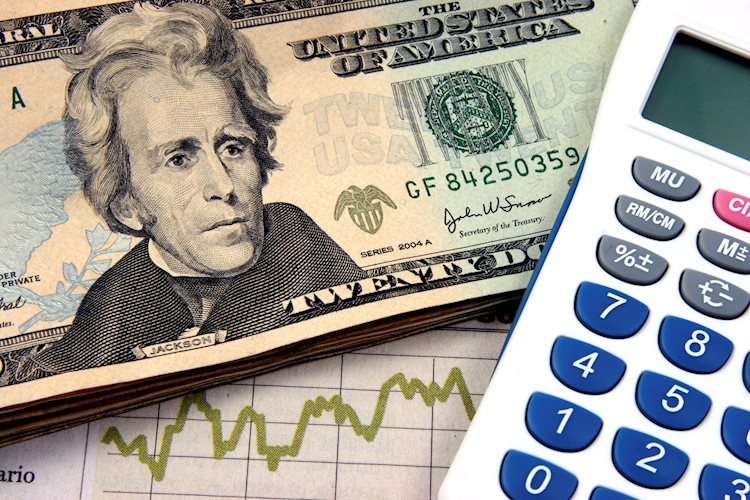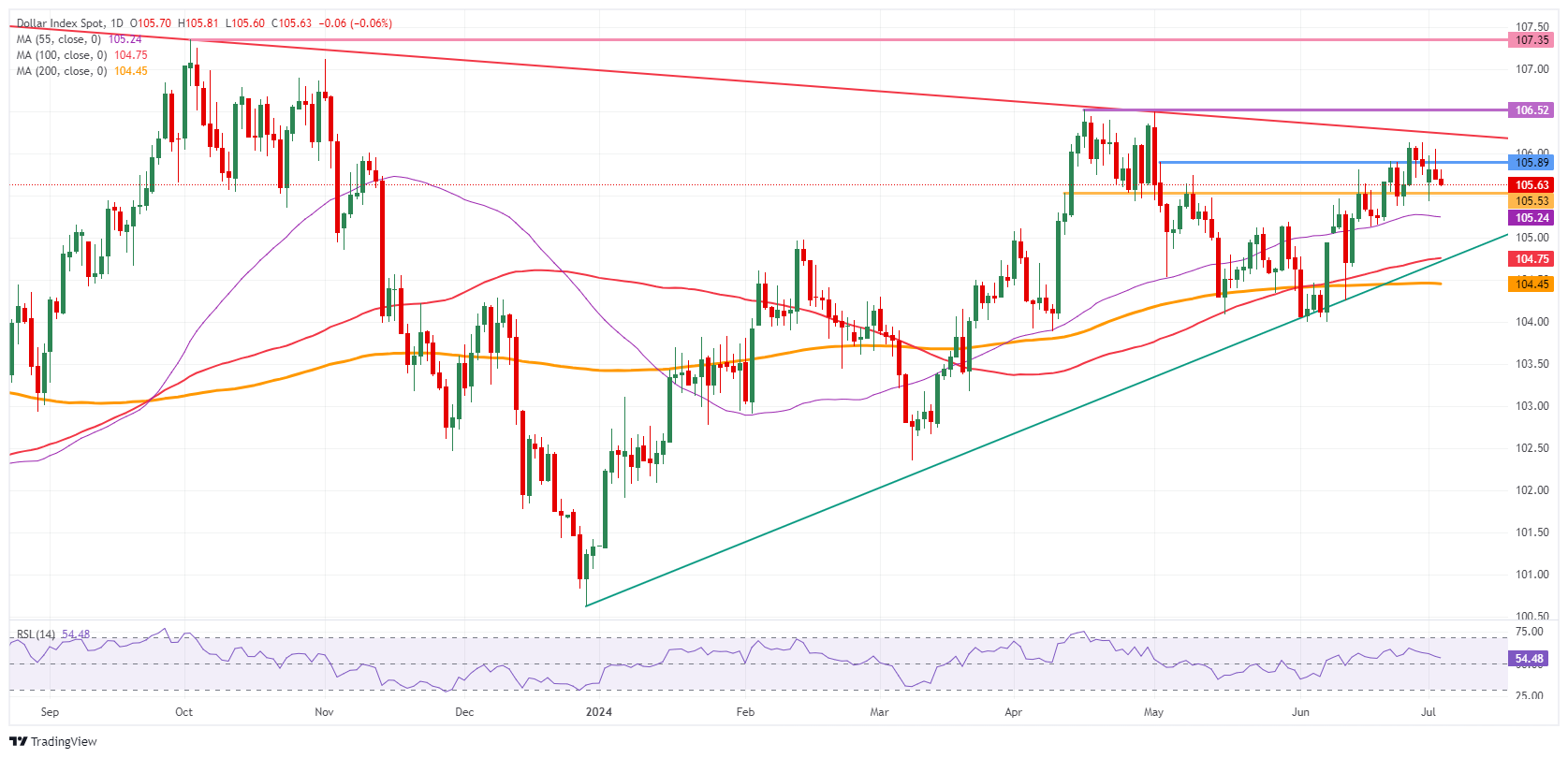Products You May Like
- The US Dollar retreats further after softer US data.
- Markets are seeing Fed’s Goolsbee break ranks and signals time to cut is near.
- The US Dollar index falls below 105.50 after US data triggers another leg lower.
The US Dollar (USD) is continuing its easing for this Wednesday after both ADP and Initial Jobless Claims numbers confirmed and backed earlier comments from US Federal Reserve Bank of Chicago President Austan Goolsbee in Sintra during the European Central Bank symposium. Goolsbee said that keeping rates steady while inflation is coming down should also be considered as tightening and is no longer needed, suggesting interest rate cuts on the table. Ahead of the Fed’s Federal Open Market Committee (FOMC) Minutes, a bold statement to make.
On the US economic front, the calendar is very crowded on Wednesday, with many data points being moved from Thursday due to the US public holiday. The main key element, the ADP Employment Change number for June ahead of the US Nonfarm Payrolls print on Friday, came in softer than expected. Additionally, the FOMC Minutes for the June meeting will be released at the end of the day, and some volatility looks to be guaranteed.
Daily digest market movers: ADP – Jobless miss
- At 11:30 GMT, the Challenger Job Cuts for June saw a decline in job cuts from 63,816 to 48,786.
- The June ADP Employment Change data missed estimates on all fronts. An increase of 160,000 was expected after the 152,000 seen in Maym though the actual number came in at 150,000.
- Weekly Jobless Claims were exceptionally on Wednesday:
- Initial Jobless Claims for the week ending June 28 are expected to rise to 235,000 from 233,000 a week before. Though the uptick was bigger, to 238,000.
- Continuing Jobless Claims were at 1.839 million, and came in at 1.858 million for the week ending June 21.
- At 14:00 GMT, the Institute for Supply Management will release June’s Purchasing Managers Index (PMI) reading for the Services sector:
- The Employment Index was at 47.1 in May, with no forecast available for June.
- The New Orders Index was at 54.1 in May, with no forecast available for June.
- The ISM Services PMI is expected to ease to 52.5 in June from 53.8.
- The Prices Paid Index was at 58.1 in May, with no forecast available for June.
- On the Federal Reserve front, some communication on the docket:
- At 10:30 GMT, comments from the Federal Reserve Bank of New York President John Williams, who participates in a panel about drivers of equilibrium interest rates at the ECB Forum on central banking in Sintra, Portugal.
- At 18:00 GMT, the FOMC Minutes for the Federal Reserve’s June meeting will be released.
- European equities are flirting with a 1% increase on the day. US Futures are still looking for direction though are starting dig out more losses.
- The CME Fedwatch Tool is broadly backing a rate cut in September despite recent comments from Fed officials. The odds now stand at 59.9% for a 25-basis-point cut. A rate pause stands at a 34.7% chance, while a 50-basis-point rate cut has a slim 5.4% possibility.
- The US 10-year benchmark rate trades near 4.40%, and falls to the lower end for this week.
US Dollar Index Technical Analysis: Goolsbee ready for cuts, now the Fed?
The US Dollar Index (DXY) is easing a touch after Fed member Goolsbee dissented from his fellow members by saying that keeping rates steady for longer is not helping anymore. His call for rate cuts is a welcomed change after hearing each and every FOMC member saying that rates will remain steady for longer. Rate cuts should see some weakening of the Greenback, and could mean that the DXY will not be making any new highs anytime soon.
On the upside, the pivotal level of 105.89 is a must-have for additional gains. Once a daily close has taken place above that level, marching above the red descending trend line in the chart below at 106.26 and the peak of April at 106.52 are the two main resistances ahead of a fresh nine-month high. That would be reached once 107.35 is broken to the upside.
On the downside, 105.53 is the first support ahead of a trifecta of Simple Moving Averages (SMA). Next down is the 55-day SMA at 105.24, safeguarding the 105.00 round figure. A touch lower, near 104.75 and 104.45, both the 100-day and the 200-day SMA form a double layer of protection to support any declines together with the green ascending trendline from last December.
US Dollar Index: Daily Chart
Banking crisis FAQs
The Banking Crisis of March 2023 occurred when three US-based banks with heavy exposure to the tech-sector and crypto suffered a spike in withdrawals that revealed severe weaknesses in their balance sheets, resulting in their insolvency. The most high profile of the banks was California-based Silicon Valley Bank (SVB) which experienced a surge in withdrawal requests due to a combination of customers fearing fallout from the FTX debacle, and substantially higher returns being offered elsewhere.
In order to fulfill the redemptions, Silicon Valley Bank had to sell its holdings of predominantly US Treasury bonds. Due to the rise in interest rates caused by the Federal Reserve’s rapid tightening measures, however, Treasury bonds had substantially fallen in value. The news that SVB had taken a $1.8B loss from the sale of its bonds triggered a panic and precipitated a full scale run on the bank that ended with the Federal Deposit Insurance Corporation (FDIC) having to take it over.The crisis spread to San-Francisco-based First Republic which ended up being rescued by a coordinated effort from a group of large US banks. On March 19, Credit Suisse in Switzerland fell foul after several years of poor performance and had to be taken over by UBS.
The Banking Crisis was negative for the US Dollar (USD) because it changed expectations about the future course of interest rates. Prior to the crisis investors had expected the Federal Reserve (Fed) to continue raising interest rates to combat persistently high inflation, however, once it became clear how much stress this was placing on the banking sector by devaluing bank holdings of US Treasury bonds, the expectation was the Fed would pause or even reverse its policy trajectory. Since higher interest rates are positive for the US Dollar, it fell as it discounted the possibility of a policy pivot.
The Banking Crisis was a bullish event for Gold. Firstly it benefited from demand due to its status as a safe-haven asset. Secondly, it led to investors expecting the Federal Reserve (Fed) to pause its aggressive rate-hiking policy, out of fear of the impact on the financial stability of the banking system – lower interest rate expectations reduced the opportunity cost of holding Gold. Thirdly, Gold, which is priced in US Dollars (XAU/USD), rose in value because the US Dollar weakened.

